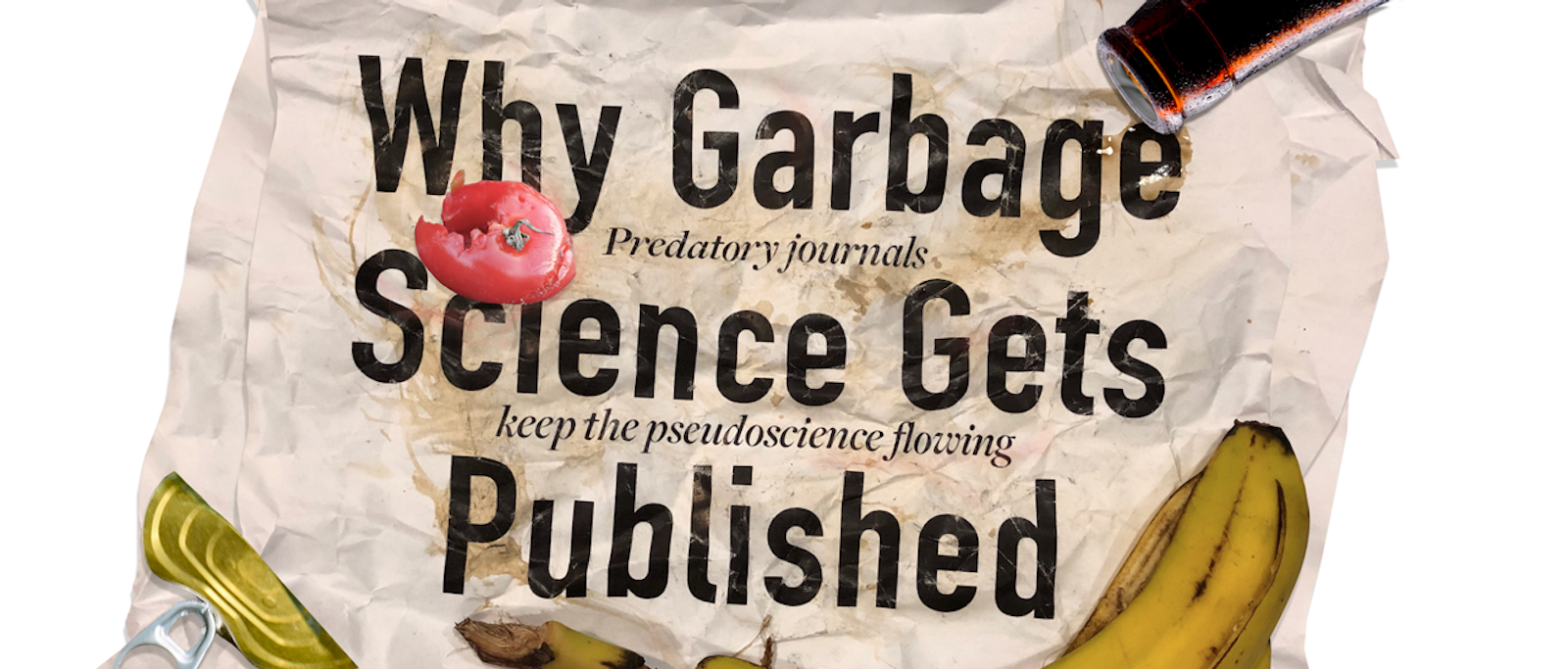In December 2014, the publisher Scientific Research issued a retraction notice for a paper that had appeared in its journal Health with the anodyne title “Basic Principles Underlying Human Physiology.” According to the notice, the action resulted from “the fact that the contents of this paper need further research and study.”1
Except that they don’t. A quick look at the now-retracted article reveals that it is an effort to promote the false and wholly discredited notion that the human immunodeficiency virus (HIV) does not cause AIDS: “HIV is not etiologically involved in AIDS. It is just a common retrovirus found in AIDS conjuncturally. There is only AIDS that may not be strictly associated neither to a primary immune deficiency nor to an acquired immune deficiency. Actually, heart failure represents the causal factor of AIDS and many other ‘primary’ immune deficiencies …”2
Opinion pieces that “represent the viewpoint of an individual” and offer hypotheses without testing them are the opposite of science.
The retraction notice ends with a laughable, and head-scratching, assurance: “Health strives to promote the circulation of scientific research, offering an ideal research publication platform to the world with specific regard to the ethical, moral and legal concerns involved. We would like to extend our sincere apologies for any inconvenience it may cause.”1
What all that means is anyone’s guess—which is nicely ironic, given that the article being retracted was a classic example of pseudoscience.
Pseudoscience by definition is not supposed to find its way into scientific publications. From peer review to layers of ostensibly expert editorial scrutiny, the barriers to entry for nonsense are high—at least in theory. The reality, however, can differ substantially from the theoretical. Peer review can be porous, in that it allows errors, significant methodological problems, and misconduct into the literature. It also is vulnerable to gaming by researchers who exploit sloppy editorial processes to slip pseudoscience into the literature.
Scientific Research and other “predatory publishers”—a term coined by Jeffrey Beall to describe outfits that claim to be legitimate scientific publishers, but in reality exist only to collect researchers’ money—can be an efficient pipeline for peddlers of pseudoscience.3 For a fee, these journals will print virtually anything they receive after arranging for the most cursory of peer reviews. So much is clear from the nature of the articles they are subsequently forced to retract. The publisher Frontiers, for example, is an open-access, all-digital imprint that produces many journals, and which as of 2016 was on Beall’s list of predatory publishers,4 although some dispute the classification,5 as some dispute the legitimacy of Beall’s list—which was taken down in early 20176—altogether.7 The publisher reportedly accepts for publication nearly 90 percent of the manuscripts it receives but found itself backpedaling after one of its journals published a 2014 article questioning the link between HIV and AIDS. The article, by a researcher at Texas A&M University named Patricia Goodson, was not some Trojan horse with a bland title. Its thrust was perfectly clear from the headline alone: “Questioning the HIV-AIDS hypothesis: 30 Years of Dissent.”8
Facing a stiff backlash from readers, Frontiers retreated—but did not surrender. As the publisher explained in a notice:
Frontiers has received several complaints from public health professionals related to the article “Questioning the HIV-AIDS hypothesis: 30 years of dissent,” which questions the link between HIV and AIDS. Acknowledging the gravity of these concerns, and the implications that the speculation on the lack of an HIV-AIDS link has on public health in general, an internal investigation was conducted. During the course of the investigation, Frontiers had sought expert input from the Specialty Chief Editors of the HIV and AIDS section of Frontiers in Public Health and Frontiers in Immunology. Based on the conclusion of the investigation the article type of “Questioning the HIV-AIDS hypothesis: 30 years of dissent” has been changed to an Opinion article, which represents the viewpoint of an individual. In addition, a commentary on the article has been published “Commentary on ‘Questioning the HIV-AIDS hypothesis: 30 years of dissent,’ ” which discusses the concerns and analyzes the viewpoint within a scientific discourse on the topic.9
On its face, that explanation seems reasonable. After all, science that lacks room for debate is indistinguishable from religious orthodoxy. But opinion pieces that “represent the viewpoint of an individual” and offer hypotheses without testing them are the opposite of science. Goodson’s paper, then, would seem to be at odds with Frontiers’ ostensible commitment “to producing a high quality scientific journal of interest to researchers and practitioners from many disciplines.”10 Pseudoscience is many things, but a discipline it is not.
Frontiers in Public Health does not appear to have learned much from the experience. In late June 2016, the journal published an article in support of the bizarre and demonstrably false claim that the trails shed by jets consist not of ice crystals, as is the case, but coal fly ash, a harmful pollutant.11 The theory is a favorite of conspiracy theorists. Outraged readers immediately objected, and within three weeks, the editors issued an expression of concern about the article, soon followed by a retraction—acknowledging that the concerns about the paper were valid and that “the article does not meet the standards of editorial and scientific soundness” for the journal.12
That would have been a good place to stop, but Frontiers allowed the author, J. Marvin Herndon—who had a previous paper on coal fly ash “chemtrails” retracted—to get the last word: “The author considers the retraction to be unwarranted and therefore does not agree to the statement.”12
Lest anyone think that pseudoscience is the province solely of predatory publishers, however, even the big, top-tier houses fall victim. Springer and the Institute of Electrical and Electronic Engineers, two leading publishers, in 2014 retracted more than 120 articles that had appeared in conference proceedings after learning that they had been written not by scientists but by a convincing computer text generator called SCIgen.13 The program—a sort of industrialized version of the Sokal hoax14—allows anyone to create a “scientific paper” by simply providing author names. The resulting text and graphics look like a proper scientific paper, but are gibberish. The fact that any were published means that no one peer reviewed the manuscripts.
The barriers to entry for nonsense are high—at least in theory.
Although one might assume that journals would hold a strong hand when it comes to ridding themselves of bogus papers, that’s not always the case. In 2011, Elsevier’s Applied Mathematics Letters retracted a paper by Granville Sewell of the University of Texas, El Paso, that questioned the validity of the second law of thermodynamics—a curious position for an article in a mathematics journal, but not so curious for someone like Sewell, who apparently favors intelligent design theories over Darwinian natural selection.15

The journal’s editor, Ervin Rodin, blamed the appearance of the paper on “hastiness” and acknowledged that the article had no place in the publication. “Please accept our apologies for our erroneous judgement in even considering this paper,” Rodin replied to a critic of the Sewell article, which was eventually retracted.16
The affair ought to have ended there. But Sewell sued and Elsevier, the world’s largest scholarly publisher, blinked. Not only did it pick up the tab for Sewell’s legal fees—a $10,000 hit—but it took the unusual step of apologizing to him (although it did not order the journal to reinstate the article).17 The article was retracted, according to the notice, “because the Editor-in-Chief subsequently concluded that the content was more philosophical than mathematical and, as such, not appropriate for a technical mathematics journal such as Applied Mathematics Letters.”18
Beyond the financial remuneration, the real value of the settlement for Sewell was the ability to say—with a straight face—that the paper was not retracted because it was wrong. Such stamps of approval are, in fact, why some of those who engage in pseudoscience want their work to appear in peer-reviewed journals.
And it means that the gatekeepers of science—peer reviewers, journal editors, and publishers—need always be vigilant for the sort of “not even wrong” work that pseudoscience has to offer. Online availability of scholarly literature means that more such papers come to the attention of readers, and there’s no question there are more lurking. Be vigilant. Be very, very vigilant.
Adam Marcus, the managing editor of Gastroenterology & Endoscopy News, and Ivan Oransky, global editorial director of MedPage Today, are the co-founders of Retraction Watch, generously supported by the John D. and Catherine T. MacArthur Foundation.
Excerpted from Pseudoscience: The Conspiracy Against Science edited by Allison B. Kaufman and James C. Kaufman, forthcoming in January from the MIT Press. © 2018 Massachusetts Institute of Technology. All rights reserved.
References
1. Health editors. Announcement from Editorial Board. Health 6, 1816–1821 (2014).
2. Pavel, D. Basic principles underlying human physiology. Health 6, 1816–1821 (2014).
3. Butler, D. Investigating journals: The dark side of publishing. Nature 485, 433–435 (2013).
4. Beall, J. Beall’s List of Predatory Publishers 2016. Scholarly Open Access. (2016). Retrieved from https://scholarlyoa.com/2016/01/05/bealls-list-of-predatory-publishers-2016/
5. Bloudoff-Indelicato, M. Backlash after Frontiers Journals added to list of questionable publishers. Nature 526, 613 (2015).
6. Oransky, I. Why did Beall’s list of potential predatory publishers go dark? Retraction Watch (2017).
7. Crawford, W. Ethics and access 1: The sad case of Jeffrey Beall. Cites & Insights 14, 1–14 (2014).
8. Goodson, P. Questioning the HIV-AIDS hypothesis: 30 years of dissent. Frontiers in Public Health 2, 1–12 (2014).
9. Frontiers publishers. Publisher Statement on “Questioning the HIV-AIDS Hypothesis: 30 Years of Dissent.” Frontiers in Public Health 3 (2015).
10. Frontiers in Public Health editors. About [Journal]. Frontiers in Public Health Retrieved from http://journal.frontiersin.org/journal/public-health#about (2016).
11. Herndon, J.M. Human and environmental dangers posed by ongoing global tropospheric aerosolized particulates for weather modification. Frontiers in Public Health 4, 1–16 (2016).
12. Frontiers in Public Health editors. Retraction: Human and environmental dangers posed by ongoing global tropospheric aerosolized particulates for weather modification. Frontiers in Public Health 4 (2016).
13. Van Noorden, R. Publishers withdraw more than 120 gibberish papers. Nature (2014).
14. Sokal, A., & Bricmont, J. Fashionable Nonsense: Postmodern Intellectuals’ Abuse of Science Picador, New York, NY (1999).
15. Sewell, G. A second look at the second law. Applied Mathematics Letters (2011).
16. Oransky, I. More on Applied Mathematics Letters: Journal retracted paper questioning second law of thermodynamics. Retraction Watch (2011).
17. Oransky, I. Elsevier apologizes for Applied Mathematics Letters retraction, pays author’s legal fees. Retraction Watch (2011).
18. Applied Mathematics Letters editors. A second look at the second law. Applied Mathematics Letters 24, 1968 (2011).






























